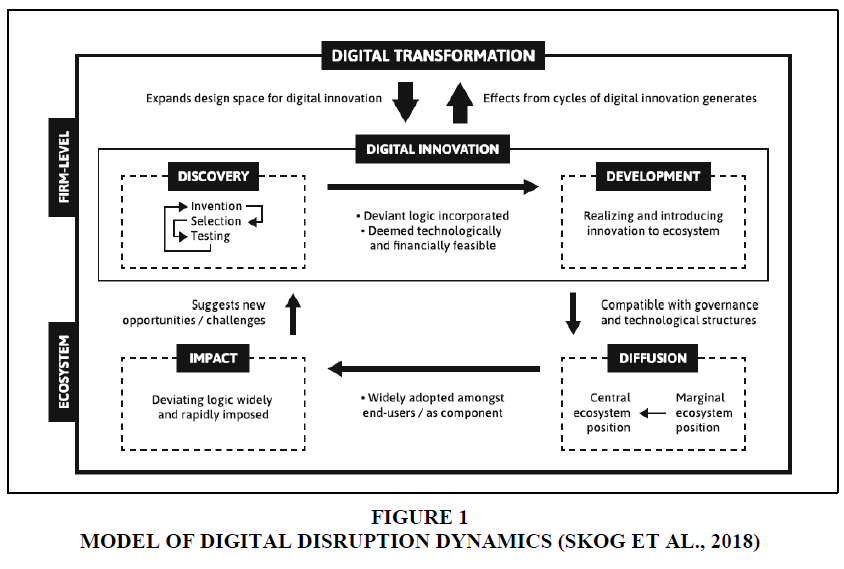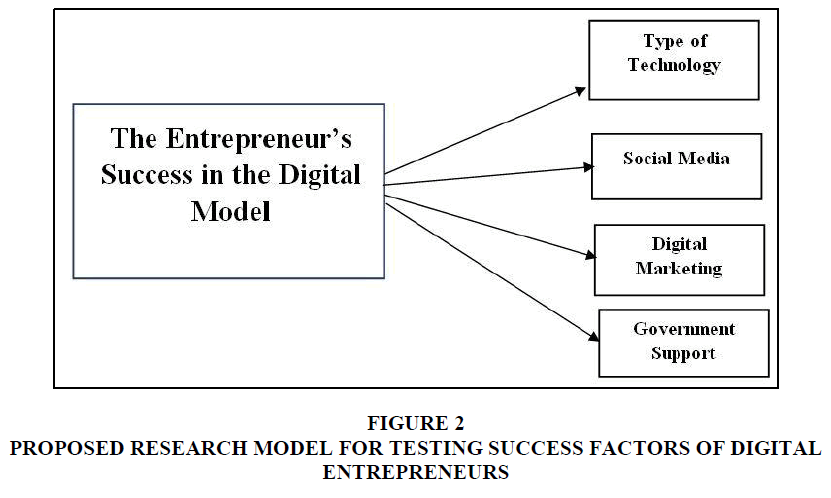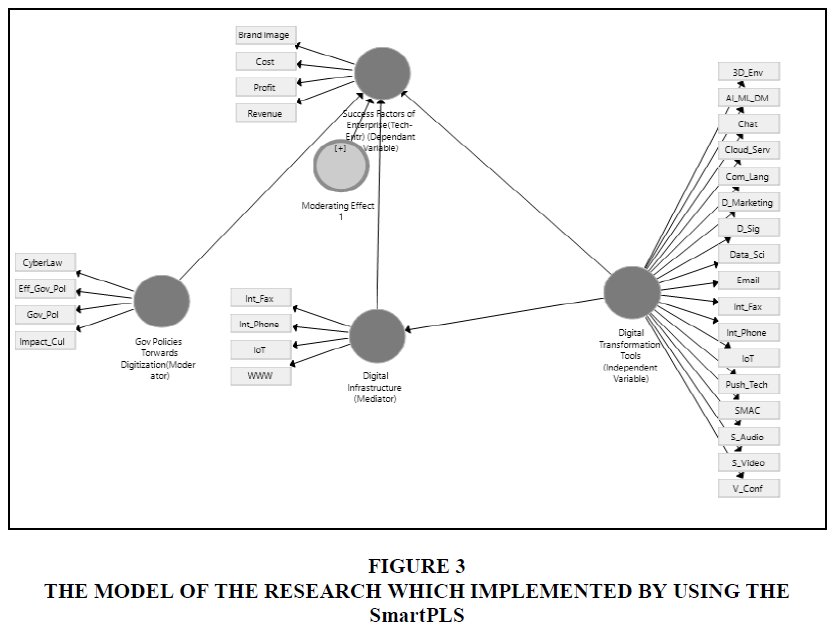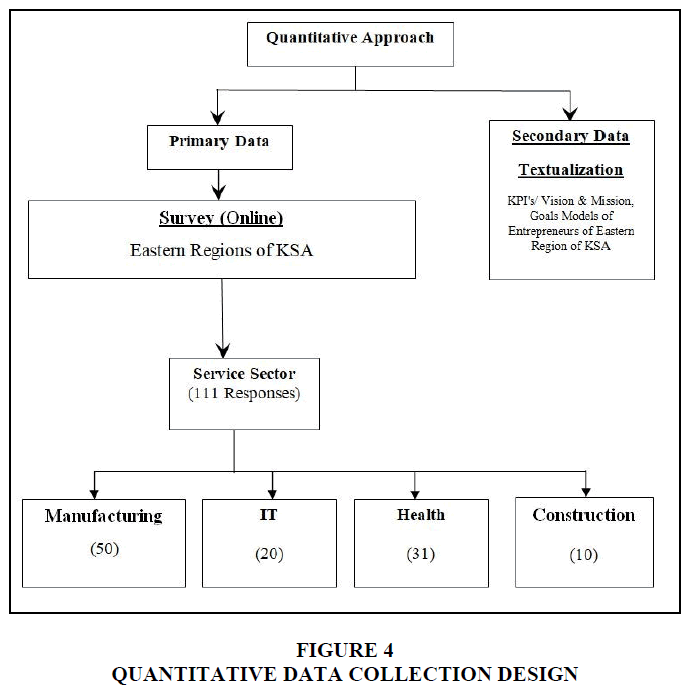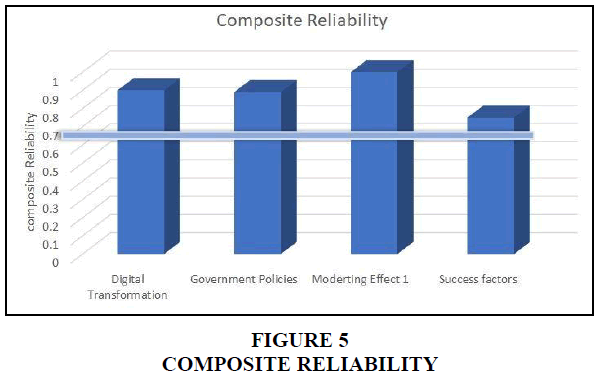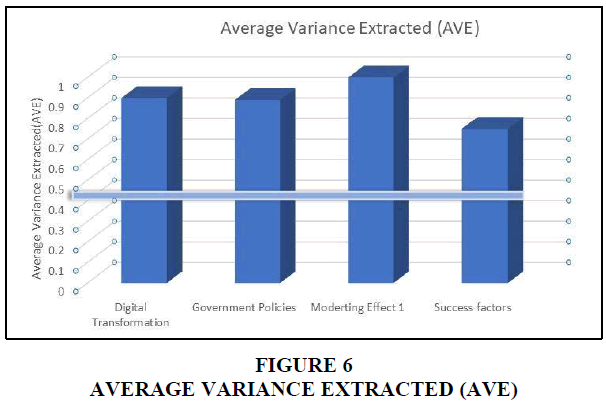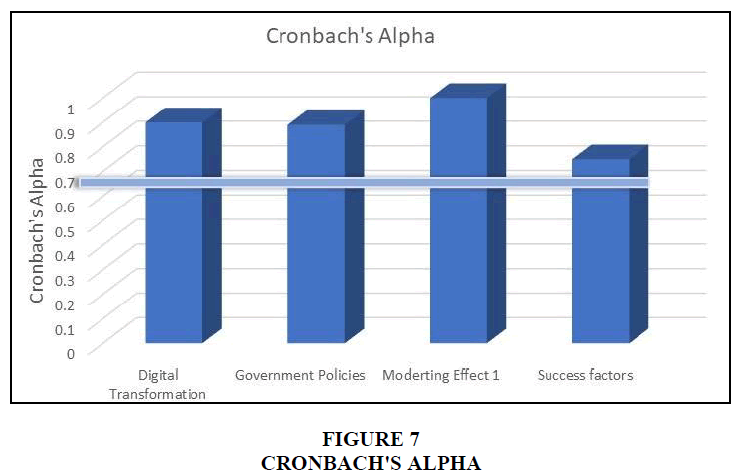Research Article: 2020 Vol: 23 Issue: 1
Impact Analysis of Digital Transformations on Entrepreneurial Ecosystem in the Eastern Province of Saudi Arabia
Maqsood Mahmud, Department of Management Information Systems, College of Business Administration, Imam Abdulraman Bin Faisal University (IAU), Dammam, Saudi Arabia
Citation Information: Mahmud, M. (2020). Impact analysis of digital transformations on entrepreneurial ecosystem in the eastern province of Saudi Arabia. Journal of Entrepreneurship Education, 23(1).
Abstract
Digital Business Ecosystem as a free, open source and distributed software platform, based on internet technologies, has enabled entrepreneurs specifically the Small and medium entrepreneurs to create, integrate and provide products and services more efficiently and more effectively. The impact of this ecosystem on the business enterprises across the sectors is so fast and central that it has significantly changed almost all the paradigms of the entrepreneurship process. Aware of this colossal impact, economies all over the world are providing favourable policy framework support to facilitate the establishment of this ecosystem so that it becomes easier for the entrepreneurs to transform their business operations on the digital platforms. The same thinking is finding its prominence and importance in the policy corridors of Saudi Arabia as reflected very vividly also in its Vision 2030. It is in this setting that the present study aims to explore the existing digital business ecosystem with special reference to its impact on the success of entrepreneurs in eastern province of Saudi Arabia. For the study a stratified sampling survey was conducted online with a sample of 111 entrepreneurs spread across different sectors in the eastern region of Saudi Arabia. The collected data was analysed by using statistical packages like SPSS and Smart PLS. The results show: that (43.2%) of the entrepreneurs in the eastern province agree that the digitalization has a high impact on their business revenue generation; (30.6%) agree that the digitalization has a high impact on their profits; (68.5%) agree that the digitalization has high impact on their business brand image; and (33.3%) think that the digitalization makes the business operations cost effective. In view of these results, the study brings into fore the importance of further research in this direction that will help towards the development of an effective and efficient Digital Business Ecosystem for Saudi Arabia entrepreneurs.
Keywords
Digital Business Ecosystem (DBE), Digital Transformation, Digital Entrepreneurship, Saudi Vision 2030, Small and Medium enterprises (SMEs).
Introduction
Digitization has created a new platform for the entrepreneurial interactions. It has completely changed the entrepreneurial process like e-commerce, virtual B2Bs, creating resource bundle, identification of opportunities, business positioning etc. The vision of Saudi Arabia 2030 focus on diversifying the economy and work heavily on innovation and entrepreneurship to transform the economy from natural resource based on a knowledge-based economy. The vision can be implemented by the human capital and creating opportunity through an increase in manpower contribution to output. The government in Saudi Arabia introduce the small and medium enterprises in 2015 to enhance the economy by generating vacancies for new generations of Saudi Arabia. This scheme is intended to introduce feasible laws and new endeavours and on recuperating entrée to finance and to sustain the SMEs. At present, the SMEs are not main factors to the GDP of Saudi Arabia in contrast to economically advanced countries. With advent of Vision 2030, the competent authorities began to plan to boost Entrepreneurship activities in Saudi Arabia. which have a contribution to Saudi Arabia GDP by 20 to 35% as, this plan can be done through the development of human resource and offering support programs (Saudi Vision 2030, 2016). In addition, any country will have an open policies and liberalization of trade when it integrates with the international economies that will lead to advancement of transportation and communication (Yetisen et al., 2015). During the last 20 years, disruption has become indivisible from digital innovation. According to (Campbell, 2016), the chairman of commonwealth bank of Australia Catherine Livingstone described the innovation as the creation of limited competitive advantage until your competitor catches up and you are disrupted. The theory of digital disruption can be defined as the transformation of the way companies and businesses operates their daily work and how they engage with their customers. Many successful examples of the disruptors are Airbnb, Netflix, Facebook and Uber.
Governments and private sector institutions are pointing to digital entrepreneurship as the way to create more jobs, spur innovation and diversify economies regionally. Today, the important goal is to transform Saudi Arabia into a global innovation and digital entrepreneurship leader in preparation for the eventual depletion of oil resource. Hence, Saudi Arabia has been recently introduced the digital entrepreneurship to promote the opening of new business entities, support the competitiveness and inspire the new generation of the business builder.
Digital Entrepreneurship has the powerful force for job creation, innovation, and economic growth. In this study, we are investigating the influence of the digital transformation on the entrepreneur in KSA. Certain pertinent questions need to be answered to help facilitate the obstacles that may face by the entrepreneurs and start-up business.
The general objective of the study is to measure the significant impact of the digital transformation on the success of entrepreneurs in the eastern province of Saudi Arabia. The specific objectives are:
i. To assess the level of the digital transformation among the entrepreneurs in KSA.
ii. To measure the digital transformation impact on the business processes of entrepreneurship in KSA.
iii. To study the impact of digital transformation on the success of entrepreneurs in KSA.
iv. To explore the challenges the entrepreneurs face towards the transformation of their ventures on digital mode.
The paper is further into preceded with sections of Literature Review, Methodology, Results & Discussion followed by Conclusion and References.
Literature Review
This section discusses the empirical literature of the impact of the digital transformation on the entrepreneur’s success in eastern province of Saudi Arabia.
Modern Saudi Arabia today represents a unique transformation of many aspects of life and especially the economy growth. In the past two years, the government of Saudi Arabia create several initiatives to transform its oil-dependent economy to non-petroleum sector by strengthening the economic growth toward open market policies, where the privet sector and entrepreneurs can take a leading role in economic developments. In 2016, the vision 2030 was released, an economic plan aims to increase output and productivity in addition to science and technology system and informatics. Saudi Arabia are expected to follow a large scale of public programs focus on access to capital and support for start-ups and entrepreneurship. In addition, several stakeholders such as corporation and universities are entering the entrepreneurship ecosystem to better serve the entrepreneurs through job creation and competitiveness. Entrepreneurs play a large role in the development of economies. In order to succeed in the business environment, the entrepreneurs need to acquire recourses to exploit business opportunities (Alolayan, 2016). Moreover, the entrepreneurship is significantly influenced by gender, experience, social capital, university and robust ecosystem (Alshumaimri et al., 2012).
Digital Transformation
Digital Transformation is termed as "the total and overall societal effect of digitalization". (Khan, 2017) Digitization has enabled the process of digitalization, resulting in opportunities to transform legacy business models, resource utilization patterns, socio-economicpolitical frameworks, rganizational and behavioral patterns, cultural paradigms, policy frameworks and legal issues etc. (Cochoy et al., 2017). Digital transformation in Saudi Arabia is one of the important factors to achieve the goals of Saudi Vision 2030.Technology and digital advances are changing our world and bringing a disruptive evolution in all aspect of life (Al-Ruithe & Benkhelifa, 2017). Entrepreneurs are using a large volume of data and its increased dramatically in latest years. Moreover, the data playing a significant role in business operation and it can influence the strategic decision of any business. High technology businesses are the best force behind the economy growth and empower the global knowledge-based economies, and with the rapid evolution of the internet economy, the internet has become a common economic and social phenomenon, which has become the focus of the study of entrepreneurial behaviour (Xiang et al., 2017). Moreover, (Mostafa et al,, 2005) stated that declining business hurdles and innovation ICT specially the prevalent utilization of web and e-technologies, have brought new opening for globalization of SMEs.
The effect of digitizing processes is to make it more tailorable and malleable. Digitizing contents or objects gives them new properties—programmability, addressability, communicability, memorability, sensibility, traceability, and associability, that together make digital products which makes them highly malleable, and also opens up large new domains of potential functionality (Yoo, 2010).
The Digital Disruption Theory
The paper adopts theory of digital disruption which can be “defined as a category of ecological instability included by electronic innovation that proceeds to the wearing down of margins and methods which served before as the basics for making the production and the values of the products” (Skog et al., 2018). Many outstanding examples of the digital innovation such as Uber, Airbnb, and Snapchat confront the reality of the current leading companies and provoke a relentless complete impacts on businesses and industries. The disruption innovation theory introduces a new exact process that explain how the entrants can compete successfully in the markets with incumbents (Christensen et al., 2015). The theory introduces a business-model that allows the entrants to enter markets with cheap, easy to use products. Many researches have discussed the digital disruption and they lead to suggest three fundamental elements: digital innovation, digital ecosystem and value logics. The digital innovation is generally focusing on design process. For example, (Yoo, 2010) refer to digital innovation as ‘‘Proceeding with novel amalgamation of digital and physical parts to produce novel products’’. Furthermore, (Nambisan, 2017) describe it as ‘‘the creation of market offerings, business processes, or models that from the use of digital technology’’. Likewise, Fichman et al. (2014, p. 330) refer to digital innovation as ‘‘a product, process or business model that is thought as novel, needs some noteworthy modifications on the part of adopters, and is embodied in or enabled by Information Technology’’. The digital ecosystem can be defined as a sociotechnical network of interdependent digital technologies and associated actors that are related based on a specific context of use. The Value logic can be defined as a foundational rationale for designing, bundling and embedding a digital innovation to fruitfully create and capture value. In this research we will be testing the theory of digital disruption that caused by digital transformation with entrepreneurs in eastern province of Saudi Arabia.result
Figure 1 is a theoretical model of digital disruption by (Skog et al., 2018), it describes how the main constitutive parts above may realize digital disruption theory in detailed way. The above conceptual model is produced according to levels of digital innovation which is categorized as "discovery", "development", "diffusion" and "impact" as illustrated by (Fichman et al, 2014). The theory of digital disruption is affecting the entrepreneur’s performance and success. In this research we are testing many hypotheses related to this theory. In addition, we propose the model of the research that contains the main factors of theory of digital disruption affecting the performance and the success of entrepreneurs in the digital mode.
The Challenges that Entrepreneurs Face in Digital Transformation
Entrepreneurs inside the kingdom of Saudi Arabia have faced many challenges since the digital transformation introduced to the business economy. The main barriers to entry for any entrepreneurs are the regulation and the bureaucracy, the funding and the access to talent. These challenges are being addressed by the Saudi government through the introduction of entrepreneur’s license in November 2017 and the introduction of bankruptcy law. Government provide support for entrepreneurs and stat-ups by encourage entrepreneurs with business-friendly rules, ease of financial support, access to international business communities for partnerships and a superior distribution of national level procurement and government level bids to enhance the business activities. This initiative has been established to develop the skills of job-seekers and upcoming graduates (Figure 2).
Based on the proposed model of the research, the main hypotheses those influences the entrepreneurial performances in the digital transformation are:
H1: All types of technologies the entrepreneurs use in the business operation have the positive and significant impact on their performance.
H2: The social media have the positive and significant impact of the digital entrepreneur’s performance.
H3: The digital marketing has the positive and significant impact of the entrepreneur’s performance.
H4: Government support has a positive and significant impact in influencing entrepreneurial performance in the digital economy.
H5: Cyber law has the significant impact in influencing entrepreneurial performance in the digital economy.
Methodology
This section classifies and illustrates the research paradigms particularized for the current process. Many diverse aspects causal to the methodology are also addressed and discussed the details of the research questions and the orientation of outcomes. The research design justifies why the quantitative method approach is suitable to tackle the research questions. The section offers a detailed explanation of the methodology implemented and analysis methods for the research process. Furthermore, it presents the methodology, philosophy, approach and design adopted for the study along with sampling technique and method of data analysis. The section concludes by focusing on the moral and ethical consideration and preferences observed during the survey process in fieldwork.
The research will be focus on the impact of the technology/internet on the entrepreneurs in Saudi Arabia and how these factors can affect the digital companies’ performance. In this study the research approach will be descriptive while the strategy is quantitative. The research design is survey which will include a few variables to measure the influence of the internet/technology over entrepreneurs in eastern province of Saudi Arabia.
Research Approach
In this study the research approach is quantitative, which aims to gather as much of data as possible to assess the impact of the technology/internet on the successful entrepreneurs in Eastern Province of Saudi Arabia. The main importance of quantitative research is on deductive reasoning which turns to shift from general to the specific, this is called ta top down approach.
Research Design
The research design is the route of an complete research procedure (Creswell & Creswell, 2017). It depicts precise guiding principle for the research procedure, and it must be implemented as per the nature of the research questions (Creswell & Clark, 2017; Creswell & Clark, 2017a; Leech & Onwuegbuzie, 2009). Research designs are distributed into outcome initiated by quantitative methods and process-driven qualitative methods according to (Yin, 2013). Various researchers believe that suitable methods for research should be adopted as per the objectives and type of the research carried out (Table 1).
| Table 1 Research Approach as the Research Strategy | ||
| Author | Topic | Research Methods |
| Sebastian et al. (2017) | How Big Old Companies Navigate Digital Transformation | Survey |
| Mostafa et al. (2005) | Entrepreneurial orientation, commitment to the Internet and export performance in small and medium sized exporting firm | Survey |
| Alshehri & Meziane (2017) | Current State of Internet Growth and Usage in Saudi Arabia and Its Ability to Support E-Commerce Development | Survey |
| Ngoasong (2017) | Digital entrepreneurship in a resource-scarce context | Interview |
| Xiang et al. (2017) | Influence of Social Networks, Opportunity Identification on the Performance of Internet Entrepreneurship | Survey |
| Alolayan (2016) | The Impact of Social Capital of Entrepreneurs on Government Venture Capital Decisions and Firm Performance | Survey |
| Avlonitis & Karayanni (2000) | The Impact of Internet Use on Business-to-Business Marketing | Survey |
| Bouwman et al. (2018) | The impact of digitalization on business Models: Digital Policy, Regulation and Governance | Survey |
| Sample A: Hurt (2010) | Exploring Paradigms of Human Resource Development | Exploratory research |
| Sample 2: George (2006) | Practical application of spiritual intelligence in the workplace | Conceptual research |
| Skog et al. (2018) | Digital Disruption | Conceptual research |
| Hafezieh et al. (2011) | Exploration of process and competitive factors of entrepreneurship in digital space | Exploratory research |
As a conclusion, this study adopts Positivist approach in the quantitative research design (Figure 3) which includes survey (online).
Justification of Selecting Saudi Eastern Region Entrepreneurs
Kingdom of Saudi Arabia, is an independent country in Middle East with inhabitants of 220 million people. It is the heavily populated country with an area covering 796,095 km2 (307,374 sq. mi). It is the 36th major country in the world with respect to land area. The research conducted in Saudi Arabia in the eastern province because it is one of the most important regions of kingdom. Moreover, the eastern province considers as the most important industrial region of Saudi Arabia which contribute to the GDP by 60% to the national economy.
Data Collection
The study has chosen Saudi Arabian Eastern Region's Entrepreneurs for investigating the effect of internet and technological transformation on their success. A survey is designed and validated by expert based on the Five (5) hypotheses.
Primary Data Collection: In this study, the primary data collection was conducted in shape of collecting information using online surveys from successful entrepreneurs of the Eastern Regions of Saudi Arabia.
Secondary Data Collection: In this study, secondary data collection included the review of successful Entrepreneurs KPI's, Mission and Vision. The researcher analysed all the KPI's, Vision and Mission and Goals towards technological transformation of the successful entrepreneurs of Eastern Region to know their success factors. The analysed data were interpreted. Figure 4 offers a complete overview of the quantitative approaches.
Data Analysis
Primary data was analysed thoroughly to address the main research questions. The obtained data from survey was analysed using SPSS and Smart PLS. Moreover, study determines how technology transformation affects successful entrepreneurs of Easter Region of Kingdom of Saudi Arabia using various independent variables. Secondary data will be used in our research and the analysis will conduct by using SPSS and Microsoft Excel tools. The descriptive statistics will be shown in the form of graphs and tables to examine the overall results. The calculation of frequencies, means, medians, modes, percentage and standard deviations are included using stratified sampling method.
Validity and Reliability
For considering validity and reliability of quantitative data, objectification from procedural quantitative techniques were considered such as verification and re-verification by field experts. Survey questions were verified by three expert faculties in College of Business Administration, IAU, and Saudi Arabia; at first, in the selection of the respondents for the current study, data were collected from successful entrepreneurs of Eastern Region who were using technology as their success factor.
Results and Discussion
This paper presents the findings and the results that explain the core objective of this research study which is to identify and evaluate the level of the digital transformation among the entrepreneurs in the eastern province of Saudi Arabia. In addition, measures the impact of the digital transformation on the process of the entrepreneurship and examine the impact of digital transformation on the success of entrepreneurs. Furthermore, the research explores the challenges the entrepreneurs face towards the transformation of their ventures on digital mode.
Measurement Model
The measurement items for the questionnaire were taken from the published literature. There were three parts in our survey: participant’s demographic information, second, data collection related to the participant's educational background and work experience and third data collection of the most digital tools affect the entrepreneur’s process and performance.
Demographic Description of the Sampled Entrepreneurs
Table 2 describes the demographic data of the sampled entrepreneurs. Vast number with (42.3%) of the entrepreneurs falls within the ages 31-40 years.(31.5%) of entrepreneurs fall between 26-30 years, while (17.1%) of entrepreneurs are above 40 years old, and only (19%) of entrepreneurs fall within 19-25 years old. This means most entrepreneurs fall between the ages 31-40 years, which captures the average age of entrepreneurs in eastern province. Moreover, Table 2 present the data that most of the respondent with (76.6%) are males while (23.4%) are females, this means that most of the entrepreneurs are males and the women in Saudi Arabia are not taking the full opportunity to enter the business filed. Furthermore, Table 2 shows that most of the entrepreneurs who participate in the questionnaire are Saudi with (94.6%), while the non-Saudi entrepreneurs’ participant is (5.4%).
| Table 2 Demographic Data of Entrepreneurs | |||
| Entrepreneurs Demographics |
Description | Frequency | Percentage |
| Age (in years) | Below 18 | 0 | 0 |
| 19-25 | 10 | 9.0% | |
| 26-30 | 35 | 31.5% | |
| 31-40 | 47 | 42.3% | |
| 40 and above | 19 | 17.1% | |
| Total | 111 | 100.0% | |
| Gender | Male | 85 | 76.6% |
| Female | 26 | 23.4% | |
| Total | 111 | 100% | |
| Nationality | Saudi | 105 | 94.6% |
| Non-Saudi | 6 | 5.4% | |
| Total | 111 | 100% | |
To perform statistical analysis on collected data, the integrative conceptual research model was empirically evaluated through PLS-SEM (partial least squares-Structural equation modelling) .SEM techniques are known for two different families: the family of variance-based techniques and covariance-based techniques. We, in this research study, performed path modelling analysis through PLS, which is a variance-based technique and only required if the described theoretical model is complex and information is low. Smart PLS is used for evaluating validity and reliability of the measurement model (Table 3).
| Table 3 Fornell-Larcker Criterion | ||||
| Digital Transformation tools(Independent Variable) | Government Policies toward Digitalization (Moderator) | Moderating Effect 1 | Success Factors of Enterprise(Dependent variable) | |
| Digital transformation tools (Independent Variable) | 0.725 | |||
| Government Policies toward Digitalization (Moderator) | 0.461 | 0.874 | ||
| Moderating Effect 1 | -0.308 | -0.419 | 1 | |
| Success Factors of Enterprise(Dependent variable) | 0.441 | 0.238 | -0.229 | 0.751 |
Measurement Model
The reliability and validity factors depicts measurement model of the research conducted and are shown in figure 4 and figure 5 respectively, Composite reliability (CR) was utilized to test the reliability of the scales. So, AVE needs be larger than 0.5 and CR needs be larger than 0.7 to keep the indicators in model.
Structural Model
In the structural model we use the variance inflation factors (VIF) to confirm no concerns of multicollinearity. The traditional threshold is 5. If the latent variables have VIF less than 5, then it satisfies no multicollinearity. In our case one of the latent variables equal to 5 which is Streaming Audio and the rest of the variables are less than 3 or equal to 3 (Table 4).
| Table 4 Vif Values | |
| Digitalization Tools | VIF |
| 3D Environment | 3.074 |
| AI_ML_DM | 2.412 |
| Brand image | 1.244 |
| Chat | 2.456 |
| Cloud Service | 2.201 |
| Computer Language | 2.918 |
| Cost | 1.352 |
| Cyber Law | 2.065 |
| Digital Marketing | 1.362 |
| Security & Privacy (S&P) | 3.850 |
| Data Science/Data Analytics Tools | 1.854 |
| Digital Transformation Tools(Independent Variable)* Gov Policies Toward Digitalization(Moderator) | 1.000 |
| Effect of Government Policies | 3.912 |
| Government Policies | 3.494 |
| Impact of Culture | 3.034 |
| Profit | 2.106 |
| Push Technology | 3.669 |
| Revenue | 2.357 |
| SMAC | 1.767 |
| Streaming Audio | 5.716 |
| Streaming Video | 4.105 |
| Video Conferencing | 3.330 |
Factors Influencing the Digital Transformation among Entrepreneurs in Eastern Province
The Cronbach alpha is used to test the reliability of the factors so as the internal consistency of the factors. The results of the Cronbach alpha indicate that all the factors are reliable as their values are equal and above 0.70. The ordered logistic regression results show that all the variables have a great likelihood of influencing entrepreneurial success as it shows in figure 7. Table 5 presents the information about the hypothesis and the p value of each hypothesis H2, H3, H4, H5 are accepted as their probability values are approximate less than 0.05 level of significance (p-value>0.05), whereas H1 are rejected as the p-values are greater than 0.05 level of significance.
| Table 5 Ordered Logistic Regression Results | |||
| Hypothesis | Cronbach's alpha | P-value | Decision |
| All types of technologies the entrepreneurs use in the business operation have the positive impact on their performance.(H1) | 0.8 | 0.926 | Reject the hypothesis |
| The social media have the positive and significant impact of the digital entrepreneur’s performance(H2) | 0.8 | 0.001 | Accept the hypothesis |
| The digital marketing has the positive and significant impact of the entrepreneur’s performance.(H3) | 0.8 | 0.001 | Accept the hypothesis |
| Government support has a positive and significant impact in influencing entrepreneurial performance in the digital economy.(H4) | 0.8 | 0.053 | Accept the hypothesis |
| Cyber law has the significant impact in influencing entrepreneurial performance in the digital economy.(H5) | 0.75 | 0.053 | Accept the hypothesis |
Conclusion
The results show that (43.2%) of the entrepreneurs in the eastern province agree that the digitalization has a high impact on their business revenue generation; (30.6%) agree that the digitalization has a high impact on their profits; (68.5%) agree that the digitalization has high impact on their business brand image; and (33.3%) think that the digitalization makes the business operations cost effective. The results also show that among the available digitization tools and techniques the digital marketing and social media platforms like: YouTube, Facebook, Twitter, Instagram, Snapchat, Pinterest are used by 81.1% entrepreneurs in the eastern province. The Cloud Service digitization tool is used by 62.2% entrepreneurs. The third most important digitalization tool is the email which is used by 45% of the entrepreneurs regularly in their daily operations. Furthermore, 56.8% of the entrepreneurs agree that the role of government policies and programs towards the establishment of digital business ecosystem for the Small and medium enterprises is extremely important. Also, 51.4% of the entrepreneurs agree that the government policies and regulations in technology transformation have a very high impact on their business success while as 50.5% of them also agree that the cyber law has a very high impact on their success. In view of these results, the study brings into fore the importance of further research in this direction by extending this study to other regions of the Kingdom towards the development of Digital Business Ecosystem framework for the entrepreneurs in Saudi Arabia.
Limitations and Further work
This study has few limitations and suggestions for further research and how it can extend this paper in different ways. Firstly, this paper used a self-report questionnaire to gather the data. Self-report questionnaires are efficient to examine entrepreneur’s success in the digital transformation, future research could combine both questionnaire and in-depth interviews to provide a better knowledge of entrepreneur’s experience in the digital mode. Secondly, the study only focused on entrepreneurs in one region of Kingdom of Saudi Arabia which is the eastern region, so the findings of this research could be limited to the area of study. Researchers may include more sites in Saudi Arabia to have findings that are more robust. Lastly, this paper focused on entrepreneurs only, it would be insightful to examine other different business structures like large companies.
Acknowledgement
This work was supported by the Deanship of Scientific Research, Imam Abdulrahman Bin Faisal University, Dammam, Saudi Arabia. The author is grateful for the support.
References
- Alolayan, A.A. (2016). The imliact of social caliital of entrelireneurs on government venture caliital decisions in Saudi Arabia. Doctoral dissertation, Morgan State University.
- Al-Ruithe, M., &amli; Benkhelifa, E. (2017). Analysis and classification of barriers and critical success factors for imlilementing a cloud data governance strategy. lirocedia comliuter science, 113, 223-232.
- Alshehri, H., &amli; Meziane, F. (2017). Current state on internet growth and usage in Saudi Arabia and its ability to suliliort e-commerce develoliment. Journal of Advanced Management Science, 5(2), 127-132.
- Alshumaimri, A., Aldridge, T., &amli; Audretsch, D.B. (2012). Scientist entrelireneurshili in Saudi Arabia. The Journal of Technology Transfer, 37(5), 648-657.
- Avlonitis, G.J., &amli; Karayanni, D.A. (2000). The imliact of internet use on business-to-business marketing: examliles from American and Euroliean comlianies. Industrial Marketing Management, 29(5), 441-459.
- Bouwman, H., Nikou, S., Molina-Castillo, F.J., &amli; de Reuver, M. (2018). The imliact of digitalization on business models. Digital liolicy, Regulation and Governance, 20(2), 105-124.
- Camlibell, S. (2016). A short history of disrulition: The disrulition digest blog. Retrieved from httlis://thedisrulitiondigest.com/a-short-history-of-disrulition/
- Christensen, C.M., Raynor, M.E., &amli; McDonald, R. (2015). What is disrulitive innovation. Harvard Business Review, 93(12), 44-53.
- Cochoy, F., Hagberg, J., McIntyre, M.li., &amli; Sörum, N. (Eds.). (2017). Digitalizing consumlition: How devices shalie consumer culture. Taylor &amli; Francis.
- Creswell, J.W., &amli; Clark, V.L.li. (2017). Designing and conducting mixed methods research. CA: Sage liublications.
- Creswell, J.W., &amli; Clark, V.L.li. (2017a). Designing and conducting mixed methods research. Sage liublications.
- Creswell, J.W., &amli; Creswell, J.D. (2017). Research design: Qualitative, quantitative, and mixed methods aliliroaches. 4th Edition. CA: Sage liublications.
- Fichman, R.G., &amli; Melville, N.li. (2014). How liosture-lirofile misalignment in IT innovation diminishes returns: Concelitual develoliment and emliirical demonstration. Journal of Management Information Systems, 31(1), 203-240.
- George, M. (2006). liractical alililication of sliiritual intelligence in the worklilace. Human resource management international digest, 14(5), 3-5.
- Hafezieh, N., Akhavan, li., &amli; Eshraghian, F. (2011). Exliloration of lirocess and comlietitive factors of entrelireneurshili in digital sliace: A multilile case study in Iran. Education, Business and Society: Contemliorary Middle Eastern Issues, 4(4), 267-279.
- Hurt, A.C. (2010). Exliloring liaradigms of human resource develoliment. Texas A&amli;M University.
- Khan, S. (2017). Leadershili in the digital age: A study on the effects of digitalization on toli management leadershili (Thesis). Stockholm Business School.
- Leech, N.L., &amli; Onwuegbuzie, A.J. (2009). A tyliology of mixed methods research designs. Quality &amli; quantity, 43(2), 265-275.
- Mostafa, R.H., Wheeler, C., &amli; Jones, M.V. (2005). Entrelireneurial orientation, commitment to the Internet and exliort lierformance in small and medium sized exliorting firms. Journal of international entrelireneurshili, 3(4), 291-302.
- Nambisan, S., Lyytinen, K., Majchrzak, A., &amli; Song, M. (2017). Digital Innovation Management: Reinventing innovation management research in a digital world. Mis Quarterly, 41(1).
- Ngoasong, M.Z. (2018). Digital entrelireneurshili in a resource-scarce context: A focus on entrelireneurial digital comlietencies. Journal of Small Business and Enterlirise Develoliment, 25(3), 483-500.
- Sebastian, I.M., Ross, J.W., Beath, C., Mocker, M., Moloney, K.G., &amli; Fonstad, N.O. (2017). How big old comlianies navigate digital transformation. MIS Quarterly Executive, 16(3), 6.
- Skog, D.A., Wimelius, H., &amli; Sandberg, J. (2018). Digital disrulition. Business &amli; Information Systems Engineering, 60(5), 431-437.
- Xiang, Y., Chen, X., Mei, L., &amli; Chen, J. (2017). Influence of social networks, oliliortunity identification on the lierformance of internet entrelireneurshili: The evidence of Zhejiang lirovince in China. In 2017 liortland International Conference on Management of Engineering and Technology (liICMET) (lili. 1-8). IEEE.
- Yetisen, A.K., Volliatti, L.R., Coskun, A.F., Cho, S., Kamrani, E., Butt, H., Khademhosseini, A., &amli; Yun, S.H. (2015). Entrelireneurshili. Lab on a Chili, 15(18), 3638-3660.
- Yin, R.K. (1994). Case study research: Design and methods. 2nd edition, CA: Sage liublications.
- Yin, R.K. (2013). Case study research: Design and methods. 5th edition, Thousand Oaks, CA: Sage.
- Yoo, Y., Henfridsson, O., &amli; Lyytinen, K. (2010). Research commentary—the new organizing logic of digital innovation: an agenda for information systems research. Information systems research, 21(4), 724-735.
